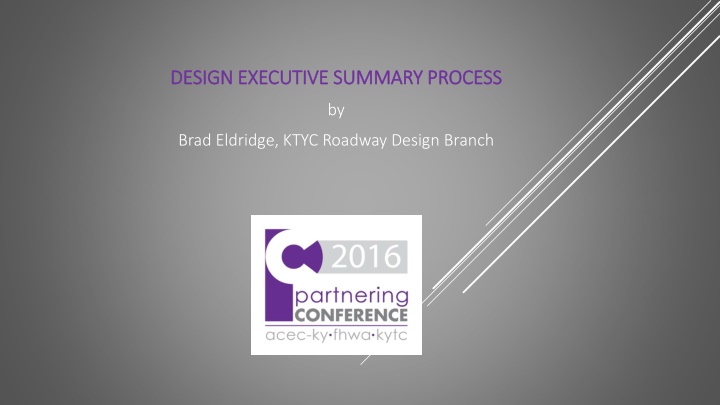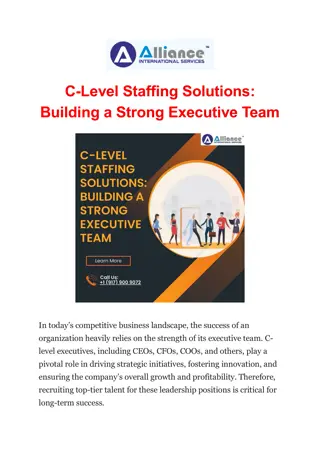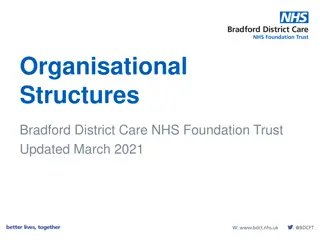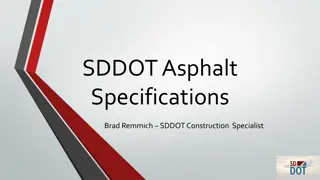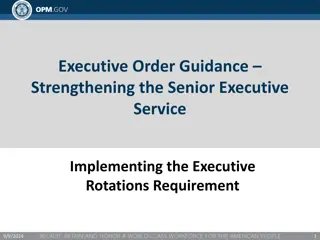Design Executive Summary Process by Brad Eldridge
"This executive summary process outlines important dates, FHWA revised controlling criteria, application of the criteria, KYTC design executive summary, and DES submittal and approval notes for roadway projects. It covers key engineering decisions, alternatives, criteria revisions, and approval procedures necessary for effective project management."
Download Presentation

Please find below an Image/Link to download the presentation.
The content on the website is provided AS IS for your information and personal use only. It may not be sold, licensed, or shared on other websites without obtaining consent from the author.If you encounter any issues during the download, it is possible that the publisher has removed the file from their server.
You are allowed to download the files provided on this website for personal or commercial use, subject to the condition that they are used lawfully. All files are the property of their respective owners.
The content on the website is provided AS IS for your information and personal use only. It may not be sold, licensed, or shared on other websites without obtaining consent from the author.
E N D
Presentation Transcript
DESIGN EXECUTIVE SUMMARY PROCESS DESIGN EXECUTIVE SUMMARY PROCESS by Brad Eldridge, KTYC Roadway Design Branch
Some Important Dates Some Important Dates 8 8- -17 17- -15 15 Informational Overview webinar on DES by Highway Design. 8 8- -28 28- -15 15 Highway Design Memo 01-15 Releasing Chapter 100 & 200 10 10- -7 7- -15 15 FHWA Published Notice with Request for Comments to 13 Controlling Criteria 5 5- -6 6- -16 16 Notice of Federal Register to Revision of Criteria *2016 Design Memo is Pending for Remaining Chapters and Updates to 200
FHWA REVISED CONTROLLING CRITERIA, 13 TO 10 & 2 FHWA REVISED CONTROLLING CRITERIA, 13 TO 10 & 2 Design speed Maximum grade Lane width Stopping sight distance Shoulder width Cross slope Bridge width Vertical clearance Horizontal alignment curve radius Horizontal clearance Superelevation rate Design loading structural capacity Vertical alignment
HOW REVISED FHWA CONTROLLING CRITERIA ARE APPLIED HOW REVISED FHWA CONTROLLING CRITERIA ARE APPLIED For high-speed (i.e., Interstate highways, other freeways, and roadways with design speed > 50 mph) roadways and on NHS all 10 criteria apply SSD applies to horizontal & vertical alignments except for sag vertical curves For low-speed (i.e., non-freeways with design speed < 50 mph) and on NHS only Design Loading Structural Capacity and Design Speed apply *For KYTC the criteria applies to all routes including those on NHS
KYTC DESIGN EXECUTIVE SUMMARY KYTC DESIGN EXECUTIVE SUMMARY The record of engineering decisions related to the project. Contains rationale concerning the identification of the preferred alternative and requested design exceptions. All alternates developed shall meet the purpose and need. Should be reasonable range alternates that are competitive. Need at least one alternate that meets the scope, schedule, and budget of the Highway Plan. Preferred alternative based on environmental, economic, and engineering issues and public input. May be used to determine environmental actions that may be required.
DES SUBMITTAL AND APPROVAL NOTES DES SUBMITTAL AND APPROVAL NOTES Projects administered by the KYTC Division of Highway Design shall require a DES unless an exemption is given by the division director. Submit DES to Highway Design after the Preliminary, Line & Grades minutes are approved by location. Typically, this would be within 30 days. Tiered approval approach is used. Mark-ups and resubmittals can be considered when evaluating consultants for Phase I or Preliminary Engineering milestone. Tracking file available for KYTC employees that shows where DES is and how many reviews have been done. Reminder to note in Consultant Monthly report when still outstanding. Noted in KYTC Project Review Meeting action reports when still outstanding.
OVERVIEW OF DES TIERED APPROVAL PROCESS OVERVIEW OF DES TIERED APPROVAL PROCESS Tier 1 DES Approvals: Tier 1 DES Approvals: Final approval requires signature of the location engineer if the following criteria are met: Environmental Document Type < CE LVIII Local or Collector Roadway Classification (non NHS) Design Year ADT < 1500 No Design Exceptions required for any Controlling Criteria (HD HD- -704 704) Preferred Alternative Cost < 115% of the Current Highway Plan [or] [or] Environmental Document Type < CE LVIII Low Volume 400 current ADT with or without exceptions Preferred Alternative Cost < 115% of the Current Highway Plan
TIERED APPROVAL PROCESS CONT. TIERED APPROVAL PROCESS CONT. Tier 2 DES Approvals: Tier 2 DES Approvals: Final approval requires signatures of the location engineer and Roadway Design Branch Manager if the following criteria are met: Environmental Document Type < CE LVIII Local or Collector Roadway Classification (non NHS) Design Year ADT < 1500 No Design Exceptions required for controlling criteria. Preferred Alignment Cost is < 115% of the Current Highway Plan [or] [or] Environmental Document Type < CE LVIII Any NHS Roadway with design speed <50 MPH (excluding interstates and freeways) No Design Exceptions required for controlling criteria. Preferred Alignment Cost is < 115% of the Current Highway Plan
TIERED APPROVAL TIERED APPROVAL PROCESS CONT. PROCESS CONT. Tier 3 DES Approvals: Tier 3 DES Approvals: Final approval requires signatures of the location engineer, Roadway Design Branch Manager, and Director of the Division of Highway Design if the following criterion is met: Environmental Document Type > CE LVIII Projects not meeting Tier 1 & 2 parameters A copy of the approved DES is returned to the PDM and the location engineer to be filed in the project file. On FHWA oversight projects the DES shall be provided to FHWA, and their approval for design exceptions shall be solicited under separate cover. FHWA approval of the design exceptions shall be made part of the project record. DES can be resubmitted or addendums made on a project need basis.
PURPOSE AND NEED PURPOSE AND NEED Provides the foundation for successful decision-making and the basis for the evaluation and comparison of reasonable alternatives for all projects. Utilized to establish the scope of the required work, including the study area and expected project deliverables. It explains to the public and decision-makers that expenditure of funds is necessary and worthwhile and that the priority of the project is warranted when compared to other needed highway projects. Demonstrate the support of the Cabinet s mission of providing a safe and reliable transportation system that delivers economic opportunity and enhances the quality of life for all Kentuckians.
PURPOSE AND NEED CONTINUED PURPOSE AND NEED CONTINUED Factors that may influence the need include: system linkage, capacity, transportation demand, legislation, social demands/economic development, modal interrelationships, safety, and roadway deficiencies. The need provides data to support the problem statement (Purpose). It should avoid stating a solution as a purpose. For example, build a bypass. Re-examine and update P&N as appropriate throughout the project development process. Helps define what the project will and will not deliver. It is not the description listed in the Highway plan.
DES EXCEPTION & VARIANCE DOCUMENTATION DES EXCEPTION & VARIANCE DOCUMENTATION Specific design criteria that will not be met Existing roadway characteristics Alternatives considered Comparison of the safety and operational performance of the roadway and other impacts such as r/w, community, environmental, cost, and usability by all modes of transportation Proposed mitigation measures Compatibility with adjacent sections of roadway Rare design speed exceptions: Length of section with reduced design speed compared to overall length of project Measures used in transitions to adjacent sections with higher or lower design or operating speeds
DES FORM AND CONTENTS DES FORM AND CONTENTS
HELPFUL WEBSITES HELPFUL WEBSITES Purpose and Need Guidance Instructions: Purpose and Need Guidance Instructions: http://transportation.ky.gov/Highway- Design/Documents/Purpose%20and%20Need%20Statement%20Guidance%20and%20Instr uctions.pdf Highway Information View and Extract Extract Interface (HIS): Interface (HIS): Highway Information View and http://datamart.business.transportation.ky.gov/EDSB_SOLUTIONS/HISEXTRACTS/ Highway Design Design DES Form: DES Form: Highway http://transportation.ky.gov/Highway-Design/Pages/HighwayDesignForms.aspx KYTC Webinar on DES: Webinar on DES: KYTC http://transportation.ky.gov/Highway-Design/Pages/Software-and-Support.aspx Design Memo for HDM Chapters 100&200: HDM Chapters 100&200: http://transportation.ky.gov/Highway- Design/Memos/01-15.pdf KYTC DES Tracking File (intranet): File (intranet): Design Memo for KYTC DES Tracking https://intranet.kytc.ky.gov/org/DPM/Pages/Status-Reports.aspx
